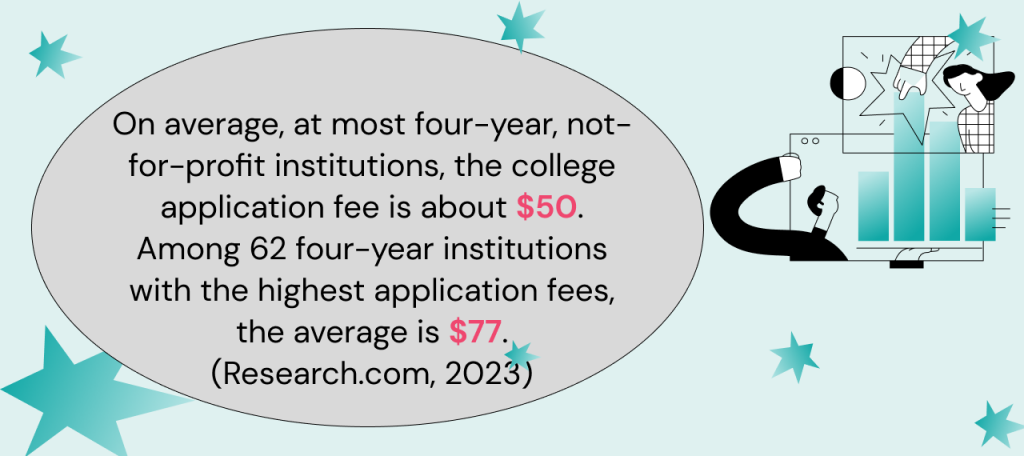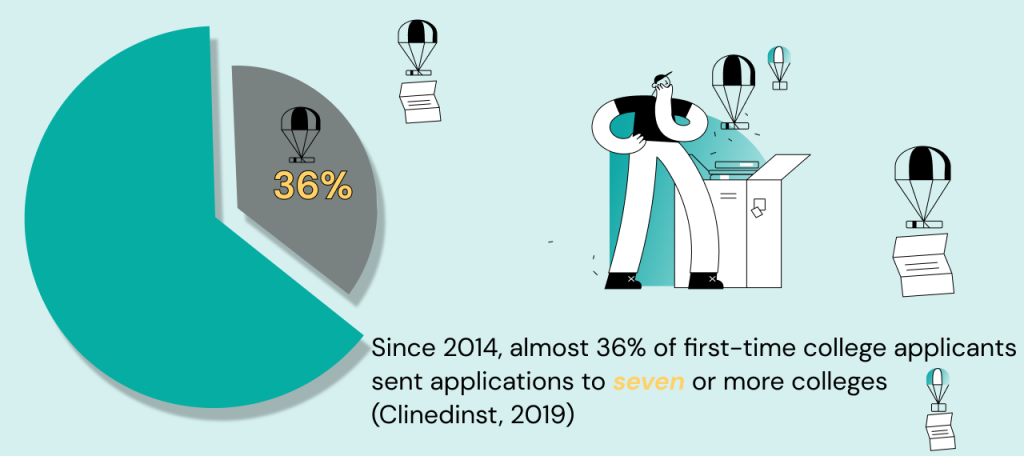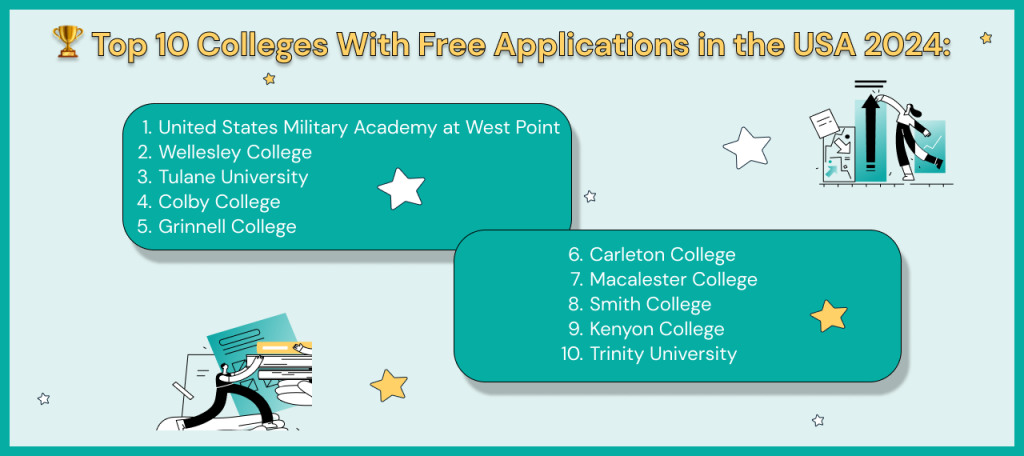Graduating from high school is a joyous time marking the end of childhood, culminating with one’s graduation ceremony, and then admission to the college of one’s dreams. While this sentimental tale sounds lovely, in reality, it’s not all sunshine and roses. Finding a suitable college can be challenging and finances play a significant role in future freshmen’s decisions. Let’s face it: Getting an education costs a lot of money. That’s why many graduates often explore colleges with no application fee. If this topic is of interest to you, we welcome you to keep reading, as we have prepared some valuable information for you.
Further in the article: |
School Application Costs Explained
When applying to colleges or universities, students are often required to pay an application fee. These fees, which vary depending on the institution, can be an important part of the college application process.
Charges might range from as little as $30 to $90 or more. Some prestigious and selective educational institutions even have application fees that exceed $100. Keep in mind that these fees are non-refundable, so unless you’re quite wealthy, it’s essential to choose your prospective schools wisely and apply to those that genuinely interest you. After all, academic reality goes far beyond the classes, including things like shopping, traveling, using a college essay writing service from time to time, or even dealing with health issues that usually come unexpectedly.
It’s critical to understand the breakdown of common components when evaluating a college application fee. As a rule, it comprises various elements, such as admission fees, processing fees, and supplemental fees.
- Admission expenses are the basic charges to review your application and evaluate your qualifications.
- Processing fees support the operational expenses related to handling your application. They ensure that all required papers are received and processed appropriately.
- Supplemental fees may apply if you choose to apply to specific programs or submit additional materials, like portfolios or recommendation letters.
State colleges and universities, often funded by the government, have cheaper application costs than private colleges. In-state applicants also tend to face lower admission charges than out-of-state applicants.
When comparing schools, it’s important to consider the total cost of education, including school tuition, charges, and live-in expenses, in addition to the registration payment.
The Reasons and Consequences of Application Fees
A college application fee is a longstanding practice in higher education institutions. While they may prompt questions and concerns, these fees serve essential purposes in the college admissions process.
- Administrative costs. Colleges receive a large number of applications each year, and processing them requires significant administrative capacities, including staff, technologies, and equipment. Admission fees help cover these costs.
- Intentionality and seriousness. By setting an application fee, universities can encourage applicants to be more intentional and thoughtful in their choices. This approach helps ensure that students applying to a particular college have a genuine interest in studying there.
- Resource allocation. Admission fees enable colleges to allocate their resources effectively. By discouraging frivolous requests, schools can focus on reviewing and evaluating claims from learners who are genuinely interested in becoming part of their academic community.
- Admission yield management. Universities aim to maintain a balance between the number of admitted students and the number who choose to enroll (admission yield). Application fees play a significant role in this strategy because they help regulate the number of enrollees.
- Supporting financial aid. Many institutions utilize entrance fee money to provide financial assistance programs for students with minimal income. By contributing to these funds, applicants indirectly raise fellow students’ chances for higher education, promoting a more inclusive and diverse college community.
Despite the fact that the reasons for introducing an application fee are quite sound, they also create a number of problems for aspiring freshmen.
- Financial barrier. Admission fees can be a pressing issue for students with limited financial resources. The expense of applying to many institutions can add up quickly, discouraging some brilliant individuals from pursuing the colleges they’re interested in attending.
- Disparities in access. Entrance fees can contribute to disparities in college access, especially for children from low-income families. Hefty fees may discourage some learners from applying to certain colleges, further widening the educational divide.
- Limited application choices. High application costs may limit the number of institutions to which a high school graduate can submit requests, lowering their chances of finding the best match for their academic and personal objectives.
- Selection bias. Application fees may inadvertently lead to selection bias, favoring applicants from affluent backgrounds who can afford to apply to multiple colleges. This could have an impact on the overall diversity and inclusion of the school community.
Waiver of College Application Fees
Entrance costs might be prohibitively expensive for certain scholars. However, schools are aware of this concern, and many of them provide application fee waivers to alleviate the burden for eligible young people. They are usually granted based on a student’s financial need.
Who is qualified for a payment waiver on their entrance request?
To receive a college application fee exemption, young people typically need to meet certain income-based qualifications. Primarily, the family’s financial situation determines these qualifications and children from low-income backgrounds often receive priority for fee waiver consideration. Moreover, learners who have been granted SAT or ACT price deductions may also qualify for college admission expense waivers, as these programs cater to economically disadvantaged students. Bear in mind that the particular qualifying criteria may differ from one school to another. There are also universities with no application fee for international students.
How to obtain fee waivers
Reducing college application fees can be a significant relief for students with limited financial means. This procedure aims to ensure that all qualifying students have the opportunity to receive a good education, regardless of their family’s income.
Here’s what you should do:
- Research eligibility. Start by researching the free application fee universities you are going to apply to. Look for information on their websites concerning fee waivers or contact the admission office. Generally, they are granted based on income levels and participation in qualifying programs.
- Gather financial information. If fee reduction is based on income qualifications, gather your relevant financial information, such as tax returns or documentation of government assistance programs. This information will be used to assess your eligibility for cost waivers.
- Request guidance from school counselors. Ask your school or college counselors for help. They are well-versed in the fee waiver process and can provide valuable insights and support in obtaining and submitting the necessary documents.
- Request SAT/ACT test fee exemptions (if applicable). If you have been granted SAT or ACT cost reductions, you may also qualify for college application fee waivers at some institutions. When registering for standardized tests, request a fee exemption to maximize your opportunities for application fee waivers.
- Fill out a fee waiver inquiry form. Payment exemption request forms and extra paperwork may be required by colleges. Be conscientious about giving correct information and meeting all deadlines.
- Apply to your chosen colleges. Before sending your applications to colleges, clarify that you are asking for a cost waiver. This will alert the admission office to process your request accordingly.
- Monitor fee waiver status. Keep track of your fee reduction status and follow up with colleges if you have not received confirmation of the fee waiver being applied to your application.
- Be selective in your applications. Although fee reduction relieves financial stress, still be selective in the schools you apply to. Focus on colleges without application fees that align with your academic and personal goals.
Obtaining college admission reduction requires careful research, organization, and the timely submission of necessary documents.
The Best Colleges With Free Applications
For students navigating the university application process, finding schools with no application fee can be a welcome relief. To assist you in your search, we’ve compiled a list of the ten best colleges with no application fee. This rating is based on Niche, a reputable platform known for its comprehensive school evaluations.
1. United States Military Academy at West Point
Located in New York, West Point, public Liberal Arts college, offers a rigorous and esteemed education while training future leaders in the military. The academy is one of the most renowned colleges with free application that is committed to attracting the best candidates.
Key facts:
|
2. Wellesley College
Wellesley, an all-women’s private Liberal Arts college in Massachusetts, is renowned for its strong academic programs and empowering community. Wellesley is one of the prestigious schools with no application fee that strives to encourage a diverse pool of talented applicants.
Key facts:
|
3. Tulane University
Located in New Orleans, Louisiana, Tulane, a private university, offers a vibrant campus and a wide range of academic opportunities. By waiving the application fee, Tulane aims to make the college application process more accessible for scholars from all walks of life.
Key facts:
|
4. Colby College
Nestled in Maine, Colby College, a private Liberal Arts school, boasts a supportive and engaged community that fosters intellectual growth. It is one of the outstanding colleges with free applications that attracts diverse and passionate learners.
Key facts:
|
5. Grinnell College
A private Liberal Arts school Grinnell, located in Iowa, is known for its commitment to social justice and academic excellence. It takes fifth place in the rating of the best colleges with no application fee. By offering free applications, Grinnell extends its welcoming approach to students looking for a unique and transformative educational experience.
Key facts:
|
6. Carleton College
Located in Minnesota, Carleton College is renowned for its liberal arts education and supportive environment. The private college’s free application policy reflects its dedication to providing equal opportunities for students seeking a personalized education.
Key facts:
|
7. Macalester College
A private Liberal Arts Macalester College, located in Minnesota, embraces global perspectives and fosters intellectual curiosity. This is one of the prominent universities with no application fee that encourages students worldwide to explore the enriching opportunities it offers.
Key facts:
|
8. Smith College
Smith, a prestigious, private liberal arts women’s college in Massachusetts. It empowers students to become leaders in a variety of disciplines. By waiving application fees, Smith ensures that all qualified applicants have an opportunity to join its empowering community.
Key facts:
|
9. Kenyon College
Located in Ohio, a private Liberal Arts Kenyon College offers a picturesque campus and a nurturing environment for intellectual growth. The college’s commitment to free applications aligns with its dedication to attracting diverse and talented students.
Key facts:
|
10. Trinity University
Trinity University is based in Texas. The private school provides a vibrant liberal arts education and a close-knit community. Trinity is one of the top-notch universities with no application fees that strives to support students from different backgrounds in their pursuit of higher education.
Key facts:
|
How to Get Admitted to Colleges With No Application Fees
Sending a request to colleges without application fee can be an excellent alternative for those trying to reduce the overall cost of the college admission process. Here is a step-by-step guide on how to apply to these schools:
- Investigate potential universities. Start by exploring colleges with no application fees. Look for a list of these educational institutions on reputable platforms or visit the colleges’ official websites to verify their application fee policies.
- Create an application checklist. Make a checklist of all the schools you are interested in applying to. Note their specific due dates for entrance requests and the required documents needed for your application.
- Collect all essential documentation. Assemble your high school transcripts, letters of recommendation, and standardized test scores. Ensure that all documents are up-to-date and available for submission.
- Complete an application form online. Schools with no application fee have online portals. Begin the admissions process by creating an account on the college’s website and carefully following the given instructions.
- Provide personal details. Enter your name, address, and contact information. Ensure that it is accurate and up-to-date.
- Share academic information. Include your grade point average in high school, class rank (if available), and any relevant extracurricular activities or honors in your application. Be honest and comprehensive in your responses.
- Include documentation that supports your claim. Upload your high school diploma, standardized test scores, and other required documents to the online application portal. Follow the specific guidelines provided by each college with no application fee for document submission.
- Compose a captivating essay. Craft a thoughtful and compelling essay that showcases your unique personality, experiences, and aspirations. Be genuine and authentic in your writing.
- Proofread. Thoroughly review all the information and documents you have provided. Check for any errors or omissions, and ensure that your application reflects your best self.
- Submit the application. Send your request through the online portal. Double-check that your submission is successful.
We genuinely hope the list of colleges with no application fee will be useful for you. Utilize the opportunity to share your unique qualities and experiences through your application, and best of luck in your college endeavors!







